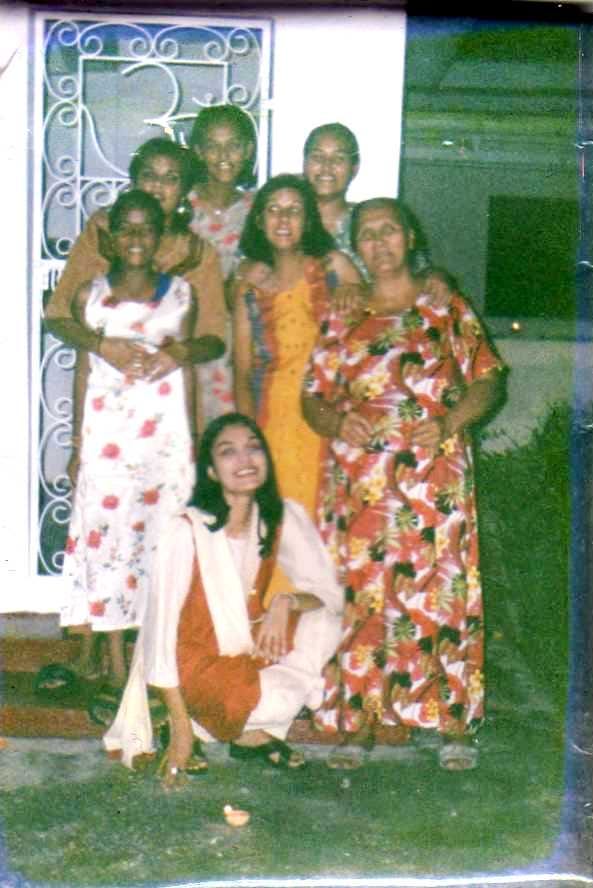We're Building a Touch-Starved Economy (And It's Profitable as Hell)
The Death of Touch in the Age of Connection
image credit pexels.com
My grandmother used to grab my face between her palms every time I visited. She'd cup my cheeks like she was trying to memorize them through her skin. "Let me look at you," she'd say, though she was doing much more than looking. She was reading me through touch.
My grandmother lived a full life and died in 2017.
This photo was taken during Diwali in the year 2000—my grandmother, aunties, cousins, and me up front.
When COVID hit three years later, I realized she would have been the first person to break quarantine rules. See, she was the kind of person who hugged the woman selling mangoes at the market, who held a stranger’s hand without hesitation during a prayer, who saw every moment with someone else as a chance to connect.
By the time we were allowed to gather again, we'd forgotten how to be close.
I can see the anti-remote work lemmings getting ready to pounce, but not so fast.
Remote work and COVID didn't create our touch deficit. It just made visible what was already happening. It also made it profitable.
A Tale of Two Countries
In America in 1940, living alone was rare, with single-person households accounting for less than 8% nationwide. Today, it's over 27%. That's an important change in how we structure intimacy. More people now live entire days without incidental touch.
No good morning kisses. No bumping into someone in the hallway.
We've created a society of untouchables, and we're proud of it.
In Trinidad, you stay in your parents' house until you marry. If you don't marry, you stay forever. This hasn't changed much. The house is always filled with people, aunts passing through, and cousins in the back room.
Touch is everywhere because bodies are everywhere.
It's not something you schedule or earn. It's just there, like humidity. The front door stays open. The yard flows into the neighbor's yard. Touch is the ambient condition.
The Workplace is Where Touch Goes to Die.
I've spent 22 years watching corporate America systematically eliminate human contact from the workplace. Every orientation includes a section on "appropriate workplace behavior," which translates to: treat your colleagues like they're radioactive.
The justification makes sense on paper. We're protecting people from harassment, establishing boundaries, and creating safer spaces. But like most corporate solutions, we've optimized for the wrong outcome.
Instead of creating better human interactions, we've eliminated human interaction entirely.
I once consulted at a company where security cameras were positioned to monitor desk conversations. Employees would gather in the basement during lunch breaks, huddling together like they were planning a heist. They'd found the one surveillance blind spot and turned it into their own private speakeasy of actual human connection.
Their solution was better than management's solution, which tells you everything you need to know about management.
What Works For Me
Not long ago, we had an in-person meeting with a client. One of the newer team members, a sharp, thoughtful young woman from Singapore, mentioned she was feeling homesick.
The instinct to offer a comforting hand on her shoulder surged through the room, but no one moved. They remained frozen in their empathy, opting for algorithmic solutions to address her human longing.
"Have you tried the mindfulness app?" someone suggested.
"Maybe book a virtual coffee with your family?"
"There's a great meditation podcast..."
Newsflash - I'm not a hugger myself, and I understand the irony of writing this entire piece about our touch deficit while being someone who flinches at unexpected hugs. But I'm not an asshole either, and even the touch-averse among us can recognize when someone needs human presence.
I did something that felt odd to everyone else. I scooted my chair closer to hers, just enough for her to feel that she wasn’t alone.
After the meeting, I hung back to chat and share a bit of advice. I’d been in her shoes 22 years earlier. I wish someone were there for me. We wrapped it up over coffee and burgers. We’ve stayed in touch ever since.
The Gendered Geography of Touch
Men, it turns out, are especially fucked.
While women can still get by with certain forms of platonic touch, hugs between friends, and comforting touches during emotional moments, men exist in a tactile wasteland. Their physical contact is either sexual, violent, or absent. Sometimes all three, if you count contact sports.
This wasn't always the case. In ancient Greece, platonic physical affection between men was not just normal but expected. Roman soldiers hugged before battle and cried openly in each other's arms after a loss. Medieval knights ritualized their emotional bonds through physical gestures of brotherhood.
I think about my male clients, successful professionals in their thirties and forties, who go weeks without meaningful physical contact. They joke about it, of course, because men aren't allowed to acknowledge need without irony.
"My barber is the only person who touches me anymore," they'll laugh-not laughing.
The sad part is we've created a culture where paying someone to touch you is more acceptable than asking a friend for a hug.
Professional cuddlers now operate in major cities, charging $80–$120 per hour for what used to be normal human contact. The fact that this service exists and thrives should horrify us. Instead, we treat it as a quirky side effect of modern life.
The Substitute Economy
Walk into any Target and you'll find an entire aisle dedicated to touch surrogates. Weighted blankets promise the sensation of being held. Heating pads that simulate body warmth. Massage chairs that knead tension from muscles that haven't been touched by human hands in months.
My personal favorite: the robotic pillow that "breathes" as you cuddle it. Because we've reached the point where we're outsourcing breathing to machines.
We've commodified comfort, monetized warmth, and turned basic human needs into subscription services. Capitalism didn't create the demand for artificial touch. It just recognized the opportunity, the opportunity we created.
The Long Way Back
I've been thinking about my grandmother's hands again, how they moved without hesitation, without calculation, without fear.
Folklore has a term for what we're experiencing: "skin hunger." Fairy tales are full of characters who waste away from a lack of human touch, Rapunzel in her tower, the Beast in his castle, and princesses under sleeping spells.
We're not going back to the days when bosses slapped secretaries on the ass and called it mentorship. That's not the goal. But we've overcorrected to the point where we're solving the wrong problem.
The goal is to rebuild human connection in a way that's appropriate, consensual, and effective.
This means:
Training people to read social cues instead of avoiding them
Creating spaces where appropriate physical interaction can happen naturally
Recognizing that some problems require human solutions, not digital ones
Understanding that physical presence isn't the same as physical contact, but both matter
Maybe that’s why so many of our interactions feel more charged than they need to be.
Ever wonder why customer service interactions feel like gladiator matches? Why standing in line at the DMV feel like a hostage situation?
People are angrier online because they're lonelier offline.
Part of it is that we're all running on empty. Our nervous systems are stuck in a permanent state of low-level alarm because we're not getting the basic social input we're designed for.
We have to remember that the body never got the memo about being modern. It’s built on primal code, still reaching for that fleeting, steadying contact with someone else.
A society that forgets how to touch becomes colder. More suspicious. More of a fustercluck!
We built this world of beautiful, sterile distance. We can unbuild it too.
One ‘touch’ at a time.
Thank you so much for taking the time :)
On Thursday, I’ll be sharing an article I previously published on Medium in ’s publication
WorkmanShit is a reader-supported publication.
To support my coffee habit, consider becoming a free or paid subscriber.
See discounted rates below:
$3 per month – The caffeine tease, just enough to make me hopeful
$4 per month – You’ve funded ¾ of a latte and 100% of my gratitude
$5 per month – You’re a saint
No cash? No problem!
Smashing that ❤️ button or sharing this post keeps the wheels on this greasy hamster wheel, too.








Another very interesting topic, sis. And the timing is interesting, just this morning on Reddit I saw a graph that showed how the size of the average house is getting larger as the size of the family shrinks. In 1790, the size of the average house in the US was under 900 sq ft and family size was roughly 6 people. Today, the size of the house is almost 2,500 sq ft, and the size of the family is just barely over 2 people. It speaks to your point that we are becoming increasingly isolated.
I’m a hugger. There—I said it. My names Mary, and I’m a hugger, kisser, hand-holder. I’m also happy.